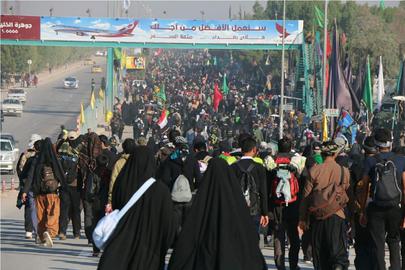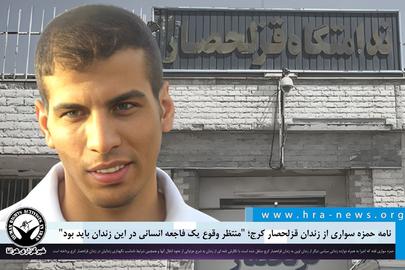For Ashura, the holiest day on the Shia calendar, worshipers traditionally gather for large demonstrations of high-scale mourning to mark the death of Hossein ibn Ali, the grandson of the Prophet Muhammad, during the seventh-century Battle of Karbala, in today’s Iraq.
Arbaeen marks the end of the 40-day mourning period, with worshipers taking part in various rituals, including a trek of hundreds of kilometers from cities around Iraq and Iran to the city of Karbala. This year’s Arbaeen fell on September 6.
The pilgrimage, which was banned by Saddam Hussein, has grown since the Iraqi dictator’s downfall in 2003. Of course, not all Shia faithfuls can embark on this pilgrimage and, in recent years, the Islamic Republic government has promoted parallel events in Tehran and other Iranian cities: the March of Arbaeen's Left Behinds.
This year’s March of Arbaeen's Left Behinds received more attention due to the participation of prominent figures in the Islamic Republic such as President Ebrahim Raisi, the commander-in-chief and former commanders of the Islamic Revolutionary Guard Corps (IRGC), the mayor of Tehran and well-known preachers affiliated with the regime.
As part of an organized and planned promotional campaign, the government’s news agencies and media outlets affiliated with the IRGC extensively covered the gatherings, amid a tsunami of social media posts featuring similar texts and pictures.
Arbaeen Has Its Own Budget
Although religious ceremonies related to Ashura and events surrounding the martyrdom of Imam Hossein have historical roots among Shias in Iran and neighboring countries, ceremonies such as the Arbaeen pilgrimage and the March of Arbaeen's Left Behinds have become a governmental affair in Iran.
The allocation of large budgets for the Arbaeen pilgrimage, at a time when many development projects in Iran have ground to a halt due to a lack of funding, has received a lot of media attention.
This year, the Ministry of Roads and Urban Development allocated 3 trillion tomans to Arbaeen ceremonies, a sum that, according to the website Didehban-e Iran (“Iran Watch”), is “equal to the budget needed to supply gas to Sistan and Baluchistan, Hormozgan and a number of other provinces that have no access to gas.”
This website also reports that 439 billion tomans were allocated in the government budget to improve the infrastructure for Arbaeen ceremonies in the western province of Kermanshah – 5.5 times the budget set for a project to reduce air pollution.
To encourage its employees to participate in the Arbaeen pilgrimage, the Ministry of Roads and Urban Development has reportedly given them three extra days off, a subsidy of 5 million tomans and 1 million tomans to each family member.
According to the report, the total amount of money earmarked by the ministry to send its employees to Arbaeen rituals amounts to 850 billion tomans, enough for the National Housing Action Plan to construct 1,500 70-meter apartment units.
Other expenses paid by the Iranian government for organizing the Arbaeen pilgrimage included the provision of more than 30,500 tons of food and 800,000 liters of gasoline to Iraq, the allocation of 30 billion tomans by Tehran Municipality, and the provision of about 400 tons of medicine and 80 ambulances by the Iranian Red Crescent Society.
Extensive planning by the Iranian government for organizing the Arbaeen pilgrimage and the use of forces in Iraq who are affiliated with the Islamic Republic for this purpose has increasingly brought this religious occasion under the brand name of the Islamic Republic. Something similar is now happening with the March of Arbaeen's Left Behinds, an occasion that has been covered extensively by government-affiliated media.
A Totalitarian Rationale
Why does the Islamic Republic want to create new religious ceremonies such as the March of Arbaeen's Left Behinds? Sociologist Eli Khorsandfar tells IranWire that a totalitarian system seeks to create a framework that, when seen by outside observers, gives the impression that the ideology of the ruling regime pervades every group in society.
According to Khorsandfar, the Islamic Republic wants to turn a fabricated or distorted image into reality so that those who feel their identity falls outside such a framework would feel alienated from society. This “alignment” process is followed up by propaganda.
After its establishment, the Islamic Republic considered organizing street rallies and marches on various political and religious occasions as a part of its propaganda program. From the anniversary of the 1979 Islamic Revolution and the anniversary of the occupation of the US embassy in Tehran in the same year to Quds Day in support of the Palestinians are all occasions that the Islamic Republic uses to bring its supporters to the streets.
According to Khorsandfar, the Islamic Republic is now speeding up this “alignment” process in order to give dissidents a sense of alienation from society. It is spending a lot of money for propaganda purposes to show Iranians and the international community that all strata of Iranian society strongly believe in its ideology.
“Considering last year’s protests, the government believes that it has been a little slow in carrying out the alignment process and has not taken this process seriously enough. Therefore, it feels that it must speed up this process in areas where it is afraid it has not done enough,” Khorsandfar says. “The intensification of this alignment process, especially now that the regime is threatened by collapse, shows that the regime feels it is facing a religious ideological vacuum and is losing those who believe in its religious ideology, so it wants to use propaganda to create a sense or an illusion of power.”
Creating Religious Occasions
Establishing national and public occasions is not a new practice but in many countries these occasions are centered on events that everybody agrees are suitable to express their social solidarity, events such as victory in a war or gaining independence.
According to Khorsandfar, in most countries religious occasions and ceremonies have been replaced by civil occasions which allow society to express its solidarity, its ideals and its achievement. In Iran, however, the Islamic Republic creates occasions and ceremonies and suppresses ideas and ideals with which it disagrees.
The Islamic Republic, which has consistently sought to conquer the streets by its supporters, continues this process of ideological alignment, as though it always desperately needs a seal of approval for decisions made by the rulers and for their actions.
This time, however, Khorsandfar believes the situation is different because Iranian society has come to despise the ruling ideology and is extremely angry at those who wield power. As a result, the Islamic Republic is only making dissidents more enraged by creating new occasions and ceremonies.
visit the accountability section
In this section of Iran Wire, you can contact the officials and launch your campaign for various problems

























comments